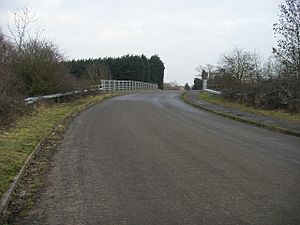Sugworth facts for kids
| Site of Special Scientific Interest | |

View near Sugworth
|
|
| Area of Search | Oxfordshire |
|---|---|
| Interest | Geological |
| Area | 0.6 hectares (1.5 acres) |
| Notification | 1986 |
| Location map | Magic Map |
Sugworth is a special place in Oxfordshire, England. It is a small area, about the size of one and a half football fields. This site is very important for understanding Earth's history.
It is known as a Site of Special Scientific Interest (SSSI). This means it has unique natural features. Sugworth is special because of its geology. It helps scientists learn about ancient times.
Contents
What Makes Sugworth Special?
Sugworth is a "geological" SSSI. This means it is protected because of its rocks and landforms. These features tell us about Earth's past. The site became protected in 1986.
Scientists study places like Sugworth. They learn about how the land changed over millions of years. It is also a Geological Conservation Review site. This means it is one of the best places in the UK to study geology.
A Look Back in Time: The Cromerian Stage
The rocks and soil at Sugworth are very old. They date back to a time called the Cromerian Stage. This was an "interglacial" period. An interglacial is a warmer time between two ice ages.
The Cromerian Stage happened over half a million years ago. Imagine how long ago that was! During this time, the climate was warmer than it is today. This period is important for understanding Earth's climate history.
Ancient River Channels and Clay
At Sugworth, scientists found an old river channel. This channel was cut into a type of rock called Kimmeridge Clay. Kimmeridge Clay formed during the Late Jurassic period. This was about 150 million years ago.
The Late Jurassic was a time when dinosaurs roamed the Earth. The clay tells us about the ancient environment. It shows that a river once flowed through this area.
What Fossils Can We Find?
The river channel at Sugworth is full of amazing discoveries. It has rich deposits of ancient life. These deposits include many different types of fossils.
Scientists have found fossils of "vertebrates." These are animals with backbones, like fish or early mammals. They also found "ostracods," which are tiny crustaceans. "Molluscs" like snails and clams are also present.
Even ancient "beetles" have been found here. There are also plant remains and "pollen." Pollen helps scientists understand what plants grew there. All these fossils help paint a picture of life long ago.

